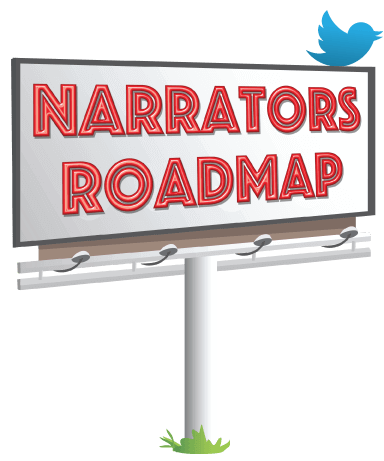If you’ve been hired by an author, their rep, or a small print publisher, you’ll find it helpful to send an information packet at the outset that establishes expectations for both sides. When working directly with the author, you can request that the author provide you with character descriptions and pronunciations of any made-up words, supply them with an outline of your workflow, and establish expectations for payment.
When a producer or audiobook publisher hires you, though, be aware that you should NOT contact the author without first obtaining permission from your producer. Authors often license their audio rights and are not part of the audiobook production process.
Otherwise, when working with indie authors, many rights holders want you to upload chapters individually so that they can listen and critique them. As the producer, you should only upload the files of the complete, finished product. Revisions requested by the RH should be only of a technical nature, such as a mis-read or mispronunciation, rather than those based on artistic or stylistic choices.
This type of situation often becomes one of micro-management where the rights holder tries to act as a director after the fact.
Audiobook narration is a performance art based on the narrator’s interpretation of the text. The rights holder is not the director and should not expect to attend the recording sessions or re-shape the performance during the corrections process. In the same way that the author of the book is not present during the movie production of the book, their presence in an audiobook recording session would be disruptive to the recording artist and against the industry best practices.
Even in a case where the author would be willing to pay real time studio hours (as opposed to finished hours) in order to attend the recording sessions, the narrator should not accommodate this proposal. The author usually has not had any training in acting or directing and might not be able to communicate nuanced changes to the narrator.
The steps listed below outline the industry standard approach for the production process. While they aren’t rules set in stone, this workflow makes each step its most efficient.
Anyone who tells you things like “there are no rules” or “do whatever works for you” or “do whatever you feel comfortable with” or “don’t listen to the naysayers” is someone who wants to justify their own routine, ignores these industry best practices, and does not work for big audio publishers. If you hope to become a professional narrator, you will want to follow professional standards on independent productions.
Furthermore, deviating from these best practices can cause problems for people behind you on the path. Just as price shoppers brag about how little they paid, indie authors will tell their friends about directing sessions, critiquing chapters, and changing the narrator’s performance after the audiobook is completed.
Workflow
1) Narrator pre-reads ENTIRE book and does prep before ever setting foot in the recording booth. If the rights holder is different than the author, the RH may or may not allow the narrator to consult with the author.
1A) On ACX and Findaway Voices, the narrator records and uploads the first 15 minutes so that the narrator and rights holder can ensure they agree on tone and characterizations. This first 15 minutes does not have to occur at the beginning of the book. It can be any segment. Some audio publishers also have instituted this preliminary checkpoint.
Tanya Eby is an acclaimed narrator and a Casting Director at Deyan Audio. She wrote this excellent article about what a narrator should do if the first 15 minutes aren’t approved. She commented that an author once asked her to speed up her narration. Be aware that this sort of direction from an author on ACX can be a red flag of a project to avoid.
2) Once the RH approves the first 15 minutes, the narrator records entire book, preferably using punch and roll technique, and making all acting choices without further input from the RH. The narrator reads word-for-word only the words that are on the page and is not allowed to make changes to the text without RH approval except in cases of obvious typos. Depending on your deadline, you may need to hand off the narration to the editor on a daily basis so that their work stays just behind yours. This situation is more common when you are working for an audio publisher,
Here are a couple of additional notes about reading the words on the page:
A) At section or scene changes, you do not insert the word “Meanwhile” or anything else. If the author wanted the word “Meanwhile”, s/he would have written it.
B) Narrator Holly Adams shared a cautionary tale on Facebook and gave me permission to reprint it below.
I recently narrated a non-fiction book for [a publisher] by a prominent expert in that field. It contained many interviews, and they were verbatim. [The publisher] makes whatever cuts/adjustments they feel are appropriate with the RH BEFORE I get the script.
It had many “uhs” and “ums”, and I was required to do each one. One of my pickups was actually to redo do a sentence because I had left out one of the “uhs” (there were two in a row for a total of three).
The prominent reviews trash me out as a narrator for “choosing to leave in the uhs”, and one review is even called “Narrators take note!!”.
DON’T take note. If you are working directly with an author, you must get their permission. If you are working for [a publisher such as] Tantor, Dreamscape, Podium, etc., THAT’S NOT YOUR CALL. You can ask, but in all likelihood, your manuscript will come with an email (or when you join the roster, it will be there) that says you must record every word, and if you don’t, you will be asked to do it over.
3) Editor edits the entire book for pacing, noise reduction, and volume consistency. The goal is to enhance the performance, not change it.
4) Proofer listens and notes errors with a timecode for the editor (noises) and narrator (misreads and mispronunciations) to fix.
5) The narrator rerecords their items found by the proofer in the previous step, which are known as pick-ups.
6) The narrator sends all the pickups (usually in a single file) to the editor, who seamlessly inserts the new recordings into the appropriate places in the original audio.
7) Once the entire book is edited and proofed, the editor or mastering engineer masters the corrected audio files to achieve consistency of sound throughout the entire book.
8) That person then exports the mastered files to MP3s that adhere to the specifications and sends them back to the producer who hired them.
9) In independent projects, the narrator is the producer who then uploads the final, mastered MP3s to complete the project.
Some people start a new session for each chapter. Others use one session file for the entire book. Either option will work within the framework stated above. Real digital audio workstations (DAW) are formulated to do long-form recording.
When working with indie authors, narrators should outsource their post (steps 3, 4, and 6-8) so that the narrator can focus on the thing that makes them money: NARRATION.
Other resources on this topic:
- Budget 6.2 hours (not including prep time) in real time to create 1 finished hour as explained in this article.
- I send a link to this page on my site to rights holders at project inception to manage their expectations.
- This article for authors lists 9 things professional audiobook narrators do while recording the book that make narration a demanding and challenging performance medium.
- Narrator Tom Dheere presents an audiobook production checklist on his blog.
- Colin Firth beautifully expresses the division between the author and performer in this 1:10 video.
- Narrator Tanya Eby discusses how to keep your voice consistent during narration in this article.
- In this article on VoiceOverXtra, narrator James Romick explains punch and roll and includes links to videos demonstrating it in several DAWs. In his follow-up article, Romick compares P&R with the method of using a dog clicker during a raw record, and he includes a Reaper function and link to a Reaper video.
- This ACX blog post describes Audible’s QC procedure.
- In this 2:25 video, I show how one editor and I used iAnnotate during the corrections process. It also shows me recording the pickups.








